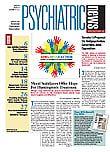Teenagers are the masters of indifference. They invented rolled eyes, shrugged shoulders, and “whatever.” But when typical teen apathy crosses the line into anhedonia, the reduced capacity to experience pleasure that is a core symptom of major depressive disorder (MDD), are there neurobiological abnormalities present?
Researchers at the New York University Child Study Center and the Nathan S. Kline Institute for Psychiatric Research recently sought to determine whether the presence of anhedonia may involve alterations in the major inhibitory neurotransmitter system of gamma-aminobutyric acid (GABA). Studies in adults have documented decreases of cortical GABA in melancholic MDD and decreases of glutamine (the molecular precursor of GABA and glutamate) in anhedonic depressed patients, but no studies have yet investigated brain GABA alterations in adolescents with MDD, said the researchers in the online October 3 Archives of General Psychiatry.
Vilma Gabbay, M.D., the medical director of the Anita Saltz Institute for Anxiety and Mood Disorders and Leon Levy assistant professor of child and adolescent psychiatry at the New York University School of Medicine, and her colleagues studied 20 psychotropic medication–free adolescents with a current episode of MDD lasting eight weeks or more; 10 of them were anhedonic, 12 were female, and all were aged 12 to 19. They all met the DSM-IV-TR diagnosis of MDD and displayed a severity score of 38 or more on the Children’s Depression Rating Scale-Revised (CDRS-R). Potential participants were excluded if they had a significant medical or neurological disorder, an IQ under 80, claustrophobia, an MRI contraindication as assessed by a standard safety-screening form, positive urine toxicology test results, or a positive pregnancy test result. A group of 21 control subjects matched for sex and age were also studied.
Using an approach that had already been demonstrated in several investigations to assess anhedonia severity, the investigators required the presence of both anhedonia and lack of mood reactivity based on semistructured interviews conducted by two child and adolescent psychiatrists (members of the research team); parents were included in the interview for participants under age 18. Anhedonia scores were computed by summing the responses associated with anhedonia on the self-rated Beck Depression Inventory and the clinician-rated CDRS-R.
The anterior cingulate cortex (ACC) region of the brain has been strongly implicated in MDD, and the region appears to be highly relevant in anhedonia, according to Gabbay and colleagues, who assessed ACC GABA levels in their study participants. “We used an imaging method called magnetic resonance spectroscopy, or MRS, which allows the noninvasive assessment of metabolite and chemical concentrations within the brain, to evaluate the ACC region in the study subjects and in the control group,” Gabbay explained to Psychiatric News. “Since GABA concentrations are considerably lower than concentrations of other neuro-chemicals, we used J-Editing MRS methodology to assess GABA.”
Compared with the controls, adolescents with MDD had significantly less GABA in their ACC regions. When Gabbay and her colleagues looked more closely at the two groups, they realized there was no difference in GABA levels between adolescents with MDD but no anhedonia and the control group: GABA appeared to be specifically implicated in anhedonia.
These findings suggest that GABA, the major inhibitory neurotransmitter in the brain, may be implicated in adolescents with MDD accompanied by anhedonia, according to Gabbay and colleagues, who cautioned that future larger studies replicating these findings as well as building on them are warranted.
Gabbay described the direction she and her colleagues have plotted to advance their findings: “We have initiated the assessment of glutamate concentrations in depressed adolescents using a newly developed MRS imaging technique. Numerous animal studies have linked glutamatergic alterations with anhedonia and depression models; moreover, the syntheses of gluta-mate and GABA are closely linked. As such, assessment of glutamate is a key to further enhancing our understanding of the neuro-biology of MDD and anhedonia.”
This study was supported by multiple grants from the National Institutes of Health, the Chrissy Rossi National Alliance for Research on Schizophrenia and Depression Award, and by gifts from the Leon Levy and Anita Saltz foundations.

